HTC U11 vs Samsung Galaxy S8: Which Android flagship is best?
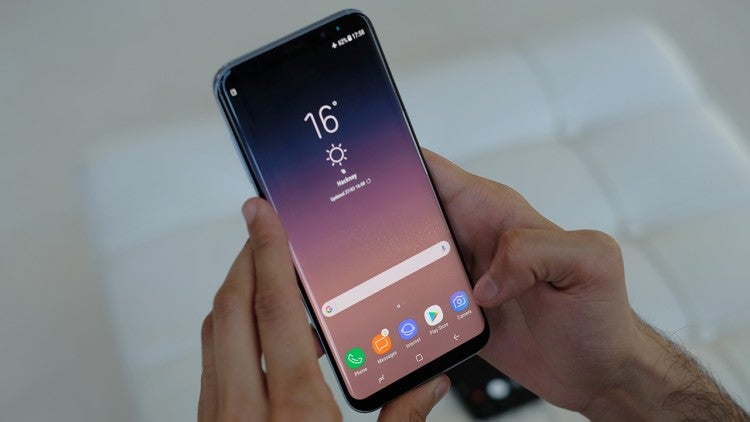
Samsung Galaxy S8 vs HTC U11: Does HTC’s latest flagship have what it takes to topple the fantastic Galaxy S8 and big sibling the Galaxy S8 Plus? We compare the specs and see how the two top Android phones stack up.
It’s taken longer than usual, but HTC has finally unveiled its 2017 flagship and follow-up to the HTC 10. It isn’t as instantly eye-catching as Samsung’s latest efforts, but let’s not discount it straight away.
We awarded the S8 and its sibling the S8 Plus full marks in their respective reviews, and they currently sit atop our list of the best Android phones to buy, thanks to stunning design and improvements in all areas.
Does the HTC U11 have anything that the S8 wishes it had? Or has Samsung already got the Phone of the Year award in the bag?
Here’s all you need to know.
Alternatively, scroll to the end for a summary of the key differences between the Galaxy S8 and HTC U11.
Related: Best Android phones
Galaxy S8 vs HTC U11 Design and Display: What’s the difference?
With the U11, HTC has ditched the metal-clad blueprint used for the majority of its One-series handsets. Instead, it opts for a mostly glass phone with metal sides for added support. There’s no fancy bezel-less display here or clever curved screen; just a fairly ordinary-looking device.
A fingerprint-scanning Home button sits below the 5.5-inch display, and there’s a slight curve to both the screen and rear thanks to the use of 3D glass. That glass is Gorilla Glass 5, by the way – identical to that found on the Galaxy S8.
The rear of the HTC U11 is highly polished, and in our short time with the phone we found it to be one of the most fingerprint-prone handsets we’ve ever laid our hands on. Hold it for mere seconds and it’s covered in marks.
Thankfully, there are some nice colours that mask the issue, including a lovely red that switches between a deep crimson and bronzey copper depending on how the sunlight hits it. The U11 is available in blue, too, along with black or white options.
- Buy Now: HTC U11 on Vodafone (16GB) £39/month, £44 upfront
- Buy Now: HTC U11 on Vodafone (32GB) £45/month, free upfront
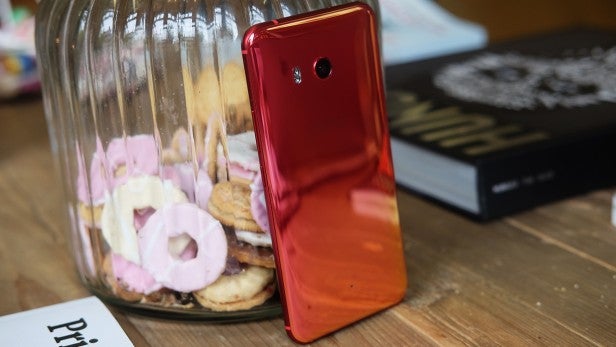
Hold the S8 and U11 side by side, though, and it’s the Samsung that stands out. The regular S8 isn’t much taller than the U11, but it has a larger 5.8-inch display and its look is far more futuristic. Both its screen and glass back curve and almost melt into each other, resulting in a phone that’s simply stunning.
Our biggest gripe with regards to the S8’s design is the awkward positioning of the fingerprint scanner, which sits next to the camera on the rear of the device.
- Buy now: Galaxy S8 (4GB) on Vodafone – £23/month, £175 upfront – use voucher TRUSTED10
- Buy now: Galaxy S8 (8GB) on Three, £32/month, £29.99 upfront
It’s one of the few poor choices Samsung has made with the S8, as having the fingerprint scanner embedded directly into the Home button – as is the case with the U11 – feels far more natural and addresses a number of issues, not least camera smudge.
Related: Galaxy S8 problems
Like the iPhone 7, HTC has ditched the traditional 3.5mm headphone jack on the U11, which is likely to prove an annoyance to quite a few people. Instead, it’s bundled a pair of active noise-cancelling earbuds in the box, along with a dongle (I do love dongles…), so you won’t need to throw away your older headphones just yet.
Samsung, meanwhile, includes a decent pair of AKG-tuned buds in the S8’s box, but the company has made the decision to retain the 3.5mm jack for another year. Both phones are water-resistant, with an IP68 rating.
There are quite a few differences in terms of display when comparing the two handsets, and we’re not just referring here to their size. The S8 comes in either 5.8-inch or 6.2-inch flavours, with that new 18.5:9 aspect ratio, while the HTC U11 has a much more common 5.5-inch 16:9 display.
Related: What is IP68?
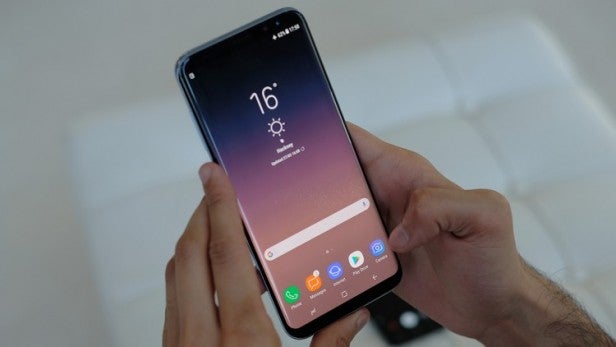
Both pack a quad-HD resolution – par for the course in 2017 – but Samsung’s panel is AMOLED and HDR-enabled, whereas HTC has gone for LCD and no HDR.
HDR (high dynamic range) is a relatively new inclusion in phones, offering better brightness and contrast in supported apps – a neat and desirable feature, but far from vital.
Related: What is HDR?
HTC U11 vs Galaxy S8 Specs and Battery Life: Which is the more powerful phone?
There isn’t really anything to separate the two phones in this area, and we suspect they’ll be two of the fastest phone out there for the majority of 2017.
Both the HTC U11 and Samsung Galaxy S8 are powered by the latest Snapdragon 835 CPUs (unless you live in some territories, including the UK, where it uses an Exynos 8895), backed by 4GB of RAM. This is a super-fast chip that’s almost too powerful for anything Android really has to throw at it.
Both the 835 and the Exynos 8895 are built using a 10nm process to improve efficiency, and we certainly noticed that the S8 managed to go much longer than we’d expect for a phone with a 3000mAh battery. The HTC U11 also has a 3000mAh cell, so we’re hoping for good stamina there, too.
Samsung has continued to include Qi wireless charging in the S8 – something the U11 lacks – but both phones have Fast Charging enabled through their USB-C port. Storage capacity is 64GB on both handsets, and this can be increased to up to 256GB via microSD card. It’s great to see the 32GB storage tier dying out for flagship phones.
Related: HTC U11 vs HTC 10
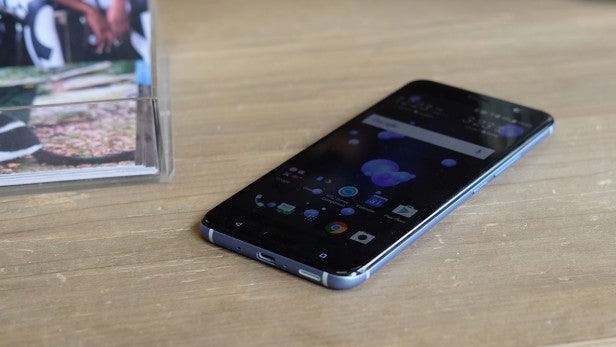
HTC U11 vs Galaxy S8 Software: Which version of Android is running on these phones?
HTC might have kept it fairly simple with the industrial design of the HTC U11, but it’s focused heavily on software features this time around.
The first of these is ‘Edge Sense’, which lets you control aspects of the phone by squeezing it. A light squeeze opens Google Assistant, and a harder squeeze takes you to the camera app. Once you’re in the camera, pressing down on the lower portion of the rim acts as a shutter button.
It’s an interesting idea, but the sensation of pressing down hard on the sides of the phone is quite odd; I constantly felt as though I was going to drop it.
HTC says it will release an app later in the year that will enable third-party apps to take advantage of these squeezy features – I was shown a clever example of it working in Google Maps, where pressing harder zoomed in – but it’s a shame this isn’t coming at launch.
HTC’s new flagship also features support for Alexa – Amazon’s voice assistant that lives inside Amazon’s Echo – but this won’t be available at launch, either.
- Buy Now: HTC U11 on Vodafone (16GB) £39/month, £44 upfront
- Buy Now: HTC U11 on Vodafone (32GB) £45/month, free upfront
Related: HTC U11 vs iPhone 7
Samsung has added its own voice assistant to the S8, but so far Bixby has fallen flat. Its lack of actual voice features – which are due to come later in the year – means it’s little more than an unhelpful portion of the homescreen.
Both phones come running Android 7.0 Nougat, although they look radically different because of the two companies’ differing implementations. Samsung’s new skin is its best yet, but there remain a couple of quirks. Swipe up to get to your apps, and there are huge number of customisation options available.
HTC’s Sense skin is a far more Google-faithful interpretation of Android, but it still benefits from deeper battery-saving modes and HTC apps such as Zoe and BlinkFeed.
Related: What is Bixby?
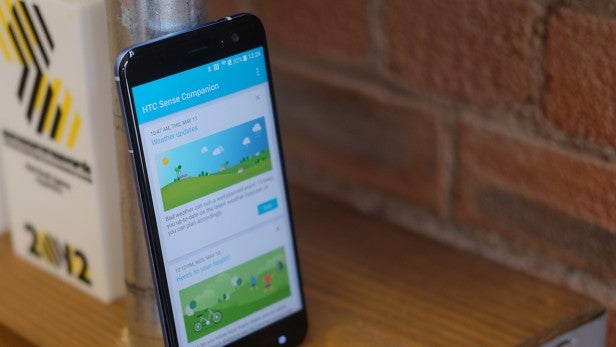
HTC U11 vs Galaxy S8 Camera: Which takes better pictures?
On paper, both the HTC and Samsung cameras look similar, boasting 12-megapixel primary sensors with OIS (optical image stabilisation), auto-HDR modes and wide f/1.7 apertures. The Galaxy S8 takes stunning pictures, so hopefully the U11 will follow suit.
On the front of the HTC U11 is a 16-megapixel sensor with an f/2.0 lens and an ‘UltraPixel’ mode for improved low-light performance, while the S8 packs an 8-megapixel sensor with autofocus on its ‘selfie’ cam.
- Buy now: Galaxy S8 (4GB) on Vodafone – £23/month, £175 upfront – use voucher TRUSTED10
- Buy now: Galaxy S8 (8GB) on Three, £32/month, £29.99 upfront
HTC U11 vs Galaxy S8 price: Which phone is better value for money?
The Samsung Galaxy S8 starts at £689 and rises to £779 for the S8 Plus model, which is damn dear for a phone. The HTC U11 does undercut the S8 marginally, starting at £649, but it’s still a pricey bit of kit. We’ll have to spend more time with the U11 to see if it warrants its price.
Galaxy S8 vs HTC U11 Summary: What’s the difference?
Here’s a short breakdown of the key differences between the Samsung Galaxy S8 and the HTC U11.
Design: Samsung has this one in the bag. Curved edge, almost full-face screen, glass body, no home button; the S8 is simply stunning. The HTC U11, on the other hand, sports a far more basic design, and we’re not sure about the shiny all-glass finish yet.
Specs: These are two very powerful phones packing top-end CPUs, 4GB of RAM and a decent 64GB of storage. Both have similar camera and battery specs on paper, too, so it could be tight.
Price: The HTC U11 is cheaper, £649 rather than £689, but they’re both very expensive phones.
What phone takes your fancy, the Galaxy S8 or the HTC U11? Let us know in the comments below.


